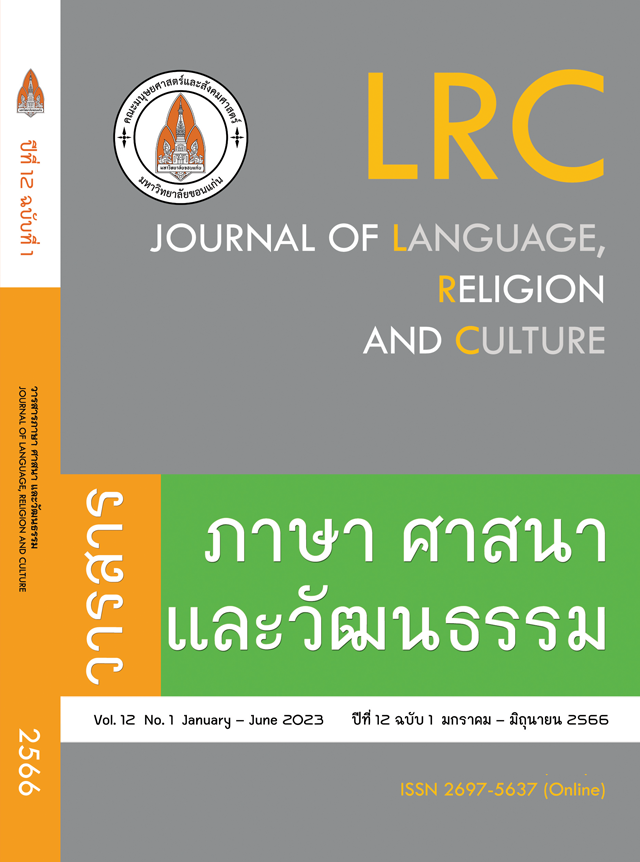Requests in Emails by Thai-Japanese Learners and Native Japanese from the Language Corpus
ลักษณะการขอร้องในอีเมลของผู้เรียนภาษาญี่ปุ่นชาวไทยและชาวญี่ปุ่นจากคลังข้อมูลภาษา
Keywords:
Requests, Email, Thai-Japanese learners, Language corpusAbstract
The objective of this research is to study request styles in the emails of Thai-Japanese learners. The requesting emails were collected from the I-Jas language corpus to analyze as data. The research found that Japanese native speakers use more diverse expressions than Thai-Japanese learners. The expressions that Thai-Japanese learners use are “V (te) itadakemasenka” and “V (te) itadakenaideshoka”. The most frequent expression found is “V (te) itadakemasenka” because this expression is recommended in Japanese textbooks at a basic level. This expression was not found in Japanese emails because it was not commonly used in formal circumstances.
In addition, the results of this study reveal that Thai-Japanese learners' use of semantic formulas exhibits both similarities and differences in comparison to that of Japanese native speakers. Specifically, similarities were observed in the use of semantic formulas to accomplish the following communicative functions: 1) stating the main point; 2) providing explanations; 3) making requests; 4) expressing gratitude; and 5) conveying apologies. However, there was a significant difference in the use of semantic formulas in requests between Japanese native speakers and Thai learners, with the former employing a greater number of these formulas to: 1) describe the situation, 2) express consideration, 3) provide additional information, and 4) request responses. Therefore, it can be said that in describing the content to illustrate the request, Japanese native speakers not only focus on explaining the cause and expressing the request but also include the four semantic formulars found in this survey. Therefore, for teaching writing skills in requesting situations, the request expressions and semantic formulars that Japanese native speakers usually use should be introduced so that learners can see the differences and apply them to their narratives appropriately and naturally, similar to those of Japanese native speakers.
References
A Corporation (2560). มินนะ โนะ นิฮงโกะ 1 [2nd Edition]. กรุงเทพฯ: สำนักพิมพ์ภาษาและวัฒนธรรม.
A Corporation (2560). มินนะ โนะ นิฮงโกะ 2 [2nd Edition]. กรุงเทพฯ: สำนักพิมพ์ภาษาและวัฒนธรรม.
Beebe, L. M., Takahashi, T., & Uliss-Welts, R. (1990). Pragmatic transfer in ESL refusals. In R.
Scarcella, E. Anderson, & S. Krashen (Eds.), Developing Communicative Competence in a Second Language (pp.57-73). New York: Newbury House.
Khamthongthip, T. (2015). The Discourse Structure of Appointment Cancellation in Email
messages in Japanese. Studies in Japanese Language and Culture, 25, 54-65.
Khamthongthip, T. (2018). Japanese Compliments on Facebook. Jsn Journal Special Edition, 8
(3), 131-144.
Masamune, M. (2000). Imperatives and Requests in Japanese. Bulletin of Hokuriku University,
, 115-124.
Miyasaki, Y. (2005). The Use of Expression for Requesting in Mobile Emails, Senshukokubun,
, 1-14.
Nakamizu, E. (1992). The Use of Request Strategies by Learners of Japanese as a Second
Language: A Sociolinguistic Approach. Machikaneyama Ronso.26, 49-69.
Okuyama, R., Chongpensuklert, T., Hsu, C. C., Choi, & Y., Saito, M. (2007). Problems of the request
expressions in E-mails of Japanese learners. Japanese Language Education Method, 14(2), 46-47.
Zhao, D. (2019). A Comparison of the Semantic Structure of Request Formulas between
Chinese Native Speakers and Japanese Native Speakers. Foreign Language Society, 21,
-30.
Downloads
Published
How to Cite
Issue
Section
License
Copyright (c) 2023 JOURNAL OF LANGUAGE, RELIGION AND CULTURE

This work is licensed under a Creative Commons Attribution-NonCommercial-NoDerivatives 4.0 International License.







